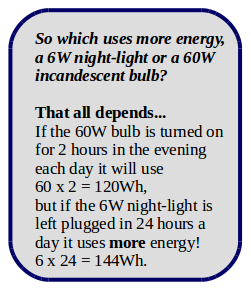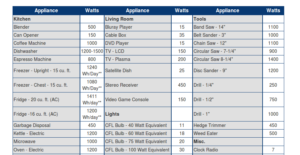 You are used to having unlimited energy available from the wall sockets in your house or business. But with an off-grid solar power system your energy is very expensive and you only have as much as your panels produce in a day. Upgrading later because your system is too small is difficult and costly, so you need to think carefully ahead of time what your needs will be for the next few years.
You are used to having unlimited energy available from the wall sockets in your house or business. But with an off-grid solar power system your energy is very expensive and you only have as much as your panels produce in a day. Upgrading later because your system is too small is difficult and costly, so you need to think carefully ahead of time what your needs will be for the next few years.
Important concepts:
- To size your panels and batteries you need to accurately estimate what lights & devices will be plugged into your power system, AND how many hours a day each device will be operating.
- Appliances and electronics often average less than what the tag on them says. The tag lists the maximum they use. You can use a device like a Kill-a-watt to measure actual energy use for an ac device and get an accurate average power draw. Average draw for dc devices can be measured with a “Watt’s Up” power meter or similar device.
- Many electronic things actually draw a little power even when they’re off. Unplugging them will save you power.
- When converting to Solar power, replacing your computers and appliances with new low-powered versions will usually more than pay for itself with the savings on your batteries and solar panels.
- AC powered devices need to use an inverter to convert the dc battery current into ac. This involves about a 20% loss in power conversion and needs to be factored in.
Watts vs. Watt-hours
If you’re fuzzy on the difference, see our What’s Watt? page. The short explanation is:
Watts are an instantaneous rate, a measure of what a device is using right now. Most devices other than light bulbs actually vary the amount of watts they are using from one second to the next. The name-plate rating printed on them is the maximum they might ever use, they will average less than that.
Watt-hours are a cumulative measure of energy used throughout the day, if you plotted your power usage on a graph of watts vs. time, the area under the line would be the watt-hours.
Calculating Daily usage
The number you need in order to size your solar panels and batteries is the daily watt-hours used by all your equipment on a normal day.
You estimate the watt-hours per day you will need by making a list of all the equipment you will be running and how many hours per day it runs, and estimating, or better yet measuring, the power it draws in watts, then multiply watts x hours for each item, and total it all up. Our Online Test Drive tool can total up the watt-hours per day for you and has suggested loads for a variety of devices field linguists might want to power.
For very small 12-V systems we have some estimates for things like cameras and tablets here on our “How many watthours” page.
 For larger ac equipment Wholesale Solar has a decent web based calculator with a look-up table of watts used by various household appliances. Note that for laptop computers most current models that will use much less than their estimate of 100 W, some can average under 10W. See our “How to choose a computer” page.
For larger ac equipment Wholesale Solar has a decent web based calculator with a look-up table of watts used by various household appliances. Note that for laptop computers most current models that will use much less than their estimate of 100 W, some can average under 10W. See our “How to choose a computer” page.
Don’t forget conversion losses
Whether you’ve used a Kill-a-watt meter to measure ac loads, or used the estimates from Wholesale Solar or elsewhere, you need to divide your result by the efficiency of the inverter. Since we’re estimating, you can assume 85% efficency, so divide by 0.85 This is the same as multiplying the predicted watt-hours by ∼1.18.
For totally dc systems, there can be a similar loss going through a dc-dc converter/regulator. Generally they don’t do much better than 85% efficiency. However, this still is much better than powering electronic devices through their power brick using ac and incurring a double conversion loss going from dc to ac then back to dc. If you’re using a dc-dc converter to bump the dc battery voltage up or down, multiply your Wh estimate by 1.18 for that device.
If you’re using our Online Test Drive tool to simulate your system, these conversion losses are automatically included and you don’t need to add them in.
Use your Calculated Daily Watt-Hours to size your Panels and Batteries
Now that you’ve got a number for your daily watt-hour needs, you can estimate the size of batteries and solar panels you’ll need. There can be reasons to vary from this, but a good rules of thumb are:
- Solar panels should be sized to produce on a yearly average day in your location about 3X your calculated daily watt-hours. See the Choosing Solar Panels page. If certain times of the year you will be using more energy or getting less sunshine, you need to size your system for the worst times of year. Our Solar Insolation Lookup Tool (SILT) gives both the yearly average, plus month-by-month averages. Use SILT to see how your solar panel output will vary during different months of the year. If the the worst month of the year prediction is at least 1.5X your calculated daily watt-hour need, you probably have enough panels. (Using a generator or doing without electricity certain days are also cost-effective options.)
- Lead-Acid batteries should be rated minimum 6X your calculated daily watt-hours. See the Sizing a Battery Bank page. (Although this sounds large, you should only be using the top third of your batteries’ capacity. If they’re rated 100 Ah you need to treat them like they’re 33 Ah. So this rule of thumb will only give you 2 days of run time without sunshine, which is minimal. See the LVD discussion page.)
- LFP batteries should be rated minimum 3X your daily watt-hours.
Go Back to the system design overview

 GTIS Power and Communications Systems
GTIS Power and Communications Systems